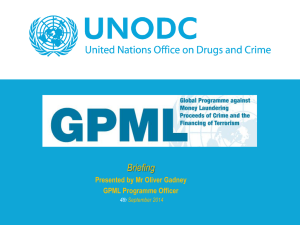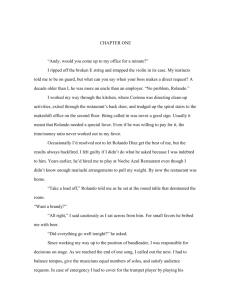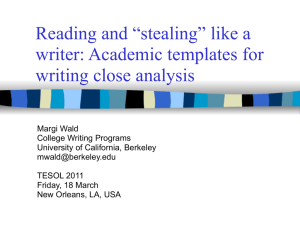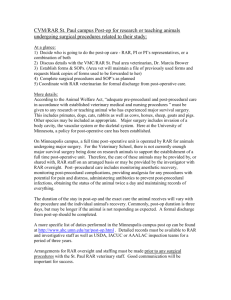Transmission Needs in a Fully Renewable Pan
advertisement
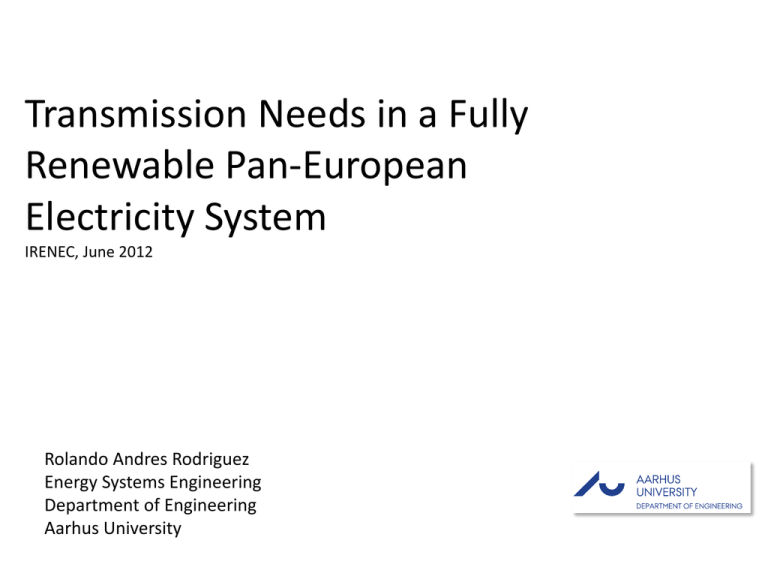
Transmission Needs in a Fully Renewable Pan-European Electricity System IRENEC, June 2012 Rolando Andres Rodriguez Energy Systems Engineering Department of Engineering Aarhus University Renewable Energy Research Group Aarhus University Group Leader Main Research Topics - Large-scale renewable energy systems - Physics of complex networks - Wind farm turbulence modeling Martin Greiner Professor, System Engineering greiner@imf.au.dk Fundamental Research Approach - Independent of policies or technological advances - Strongly dependent on reliable and thorough weather data - Based on simple mathematical models Rolando A. Rodriguez, 2012.06.28 rar@imf.au.dk 2 Model Data Weather Data Load Data 50 km x 50 km 1 hour resolution 8 year period 1 hour resolution 8 year period Allows modelling of hourly consumption/producti on for 27 European countries Possible Power Production Solar Energy Wind Energy Rolando A. Rodriguez, 2012.06.28 rar@imf.au.dk 3 Weather Variations Rolando A. Rodriguez, 2012.06.28 rar@imf.au.dk 4 Mismatch Calculation Hourly mismatch of generation and consumption: Dn (t) = a G (t)+ (1- a )G (t) - Ln (t) W n W n W n S n W(t): Normalized hourly wind power generation. S(t): Normalized hourly solar power generation. L(t): Normalized hourly electricity demand (load). Power generation is normalized according to energy output and not installed capacity. GnS (t) = GnW (t) = Ln (t) Rolando A. Rodriguez, 2012.06.28 rar@imf.au.dk 5 Residual Load Instantaneous mismatch: Residual load needs to be covered by power balancing from conventional sources! Rolando A. Rodriguez, 2012.06.28 rar@imf.au.dk 6 Optimal Mix of Wind and Solar Wind power Solar PV power Load Wind + Solar PV Load Optimising for Storage Energy ≈ 60% wind power + 40% solar power Balancing Energy ≈ 70% wind power + 30% solar power Balancing Power ≈ >70% wind power + <30% solar power Rolando A. Rodriguez, 2012.06.28 rar@imf.au.dk 7 A Fully Renewable Europe Analysed Scenario •27 European Countries •Annual Renewable Production = Annual Consumption •Existing links as of winter 2011-2012 •Optimal mix installed in all countries ≈ 70% Wind, 30% Solar What are the benefits of transmission for a fully renewable Europe? What is a sufficiently large transmission system? Rolando A. Rodriguez, 2012.06.28 rar@imf.au.dk 8 Unconstrained Power Transmission Quantifying the benefit of transmission is done through the total need for balancing Bn =(Δn-(KF)n)Which is a result of Rolando A. Rodriguez, 2012.06.28 rar@imf.au.dk • Mismatch • Net Exports 9 Unconstrained Power Transmission We identify sufficiently large quantiles on transmission limitations. Rolando A. Rodriguez, 2012.06.28 rar@imf.au.dk 10 Constrained Power Transmission • Copper Plate transmission roughly 10x actual installed capacity. • 99% Quantiles roughly 5x actual installed capacity. • Several ways to interpolate – Linear Increase of current limits – Linear Reduction of 99% Quantile limits – Implementation of intermediate Quantiles • These constraints implemented as limits on flow capacity Rolando A. Rodriguez, 2012.06.28 rar@imf.au.dk 11 Constrained Problem Statement Constraint implementation effects the following changes in the problem statement. Rolando A. Rodriguez, 2012.06.28 rar@imf.au.dk 12 Constrained Power Transmission Rolando A. Rodriguez, 2012.06.28 rar@imf.au.dk 13 Constrained Power Transmission Availability of export to neighbours Rolando A. Rodriguez, 2012.06.28 rar@imf.au.dk 14 Renewable Energy Research Group Aarhus University Martin Greiner (professor) Morten G. Rasmussen (postdoc) Gorm B. Andresen (postdoc) Dominik Heide (former ph.d/postdoc) Rolando A. Rodriguez (ph.d. student) Sarah Becker (ph.d. student) Thank you for your attention! Rolando A. Rodriguez, 2012.06.28 rar@imf.au.dk 15
